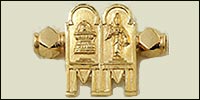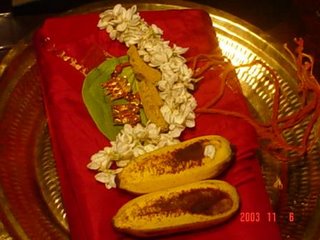


Have been wanting to write about this topic for a while now, but haven't had the time to do so. In today's modern world, a married woman makes a conscious choice to wear or not wear her thaali or mangalsutra. What does this imply?
For those who aren't familiar with the Hindu tradition of marriage, a thaali (as known in South India) or a mangalsutra (as known in North India) is tied by the groom around the neck of the bride on the day of their wedding signifying their union. The thaali is considered auspicious and is believed to protect the marriage and life of the husbands and was never usually removed in the bride's lifetime, unless her spouse died.
But like all traditions and customs, today this trend is also changing. Although, it is tied at the wedding, the younger generation women of today are choosing whether to wear it all times, or not.
For many women living outside India, the thaali is worn on and off. Some reasons for this are that- First of all, the fear that something may happen to their spouses if the woman takes off her thaali is overcome by the voice of reason and logic.
Secondly, the new era of women are confident that a mere symbolism of the thaali is not an expression of their commitment in the marriage. Most of them feel that loving your spouse and staying married doesn't come with a piece of chain around your neck.
Thirdly, the practical difficulty in wearing the thaali is that it does not blend in with western clothes or go well with party jewellery, silver jewellery, black metal etc. Earlier, the thaali was a traditional thick rope, followed by the thick gold chain and each community has their version for the pendant. Slowly, the gold rope was replaced by the "karugamani" which is made of small gold and black beads and then nowadays women have a "micro thaali" done which is fashionable, much sammer in size and weighs lesser.
Also, during work outs at the gym and other activities such as swimming etc., the thaali is uncomfortable. Not to forget mentioning that some women are allergic to the gold and even have marks on their necks.
But, many women still like to wear it at special occasions and sometimes even on a regular basis and when asked by colleagues at work are proud to explain that it is the equivalent of a wedding ring and symbolizes that a woman is married.
Life is much easier for the women abroad when you don't have a mother-in-law hovering around in the background to express shock and disbelief or a mother to express her concern when you aren't wearing the thaali.
But, for the married women in India, well, I do know some of them who work in MNCs who don't wear a thaali daily to work. But, for the others, it is a constant battle and struggle when the traditional society that is steepled in orthodoxy, culture and values fails to listen to the modern day women's perspective. Also, when the women living in US visit India, they are inclined to wear the thaali more as a way to keep the family members from reacting. Of course, there are still stronger women who hold on to their decision and boldly say that it is a matter of individual choice.
Lastly,how does the husband react to all this? Some of them who are raised in an orthodox background don't approve of their wives not willing to uphold the tradition of being married to them, while others are a lot more open to their spouses making the decision. But, secretly, most men do seem to care about whether their wives want to wear a "thaali" or not, its just that the circumstances in today's lifestyle are such that he has to make his wife have the final word on that!
Happy Friday!



























